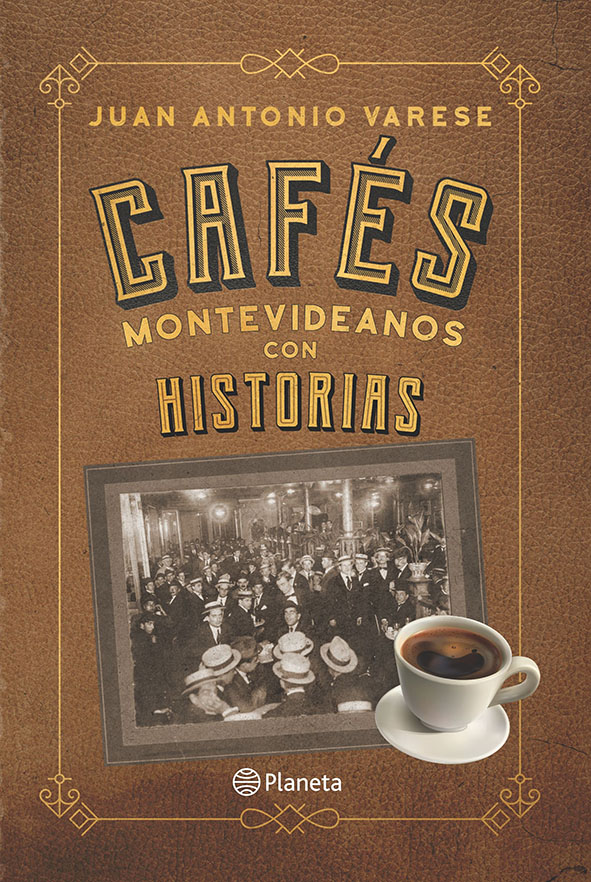Cafés montevideanos con historias.
Juan Antonio Varese. Planeta Editorial. Montevideo. 2023.
4th (24 x 16.50 cm), 432 pages, includes Cover. Publisher's binding.
The new title, the work of Juan Antonio Varese, addresses another historical heritage topic published by Editorial Planeta. The book immerses us in the world of coffee as a drink and of cafes as places of meeting, gathering, exchange and interaction.
Fundamentally, it presents the coffees of Montevideo from a historical point of view, with an initial chapter dedicated to a comparative chronology among the main ones in the world, a tour that will surprise because it reveals that some of the coffees of Buenos Aires and Montevideo are contemporaries of the most famous people from Rome, Paris and Madrid.
Through 400 pages it tells us about the events of many of the coffees that shaped Montevideo's history from the colonial era to recent times. Of which many have closed their doors and lowered their curtains as a result of the changes in our social life. A digression on the subject, on the last visit to Montevideo, days ago, Sebastián Zorrilla (owner of Zorrilla Subastas) told us that the custom of coffees has been recovered with the recent immigration of Argentines; “Many Buenos Aires residents have opened very friendly establishments that invite you to have a good time,” he said.
The book places us in time and space referring to coffee as an institution, but also to the small story, that of everyday life, that of every day with the bar of friends in that gathering where topics from literary to political, from artistic to sports, and even the way to fix the world.
The reader will be surprised by many things, among them that in Montevideo there were two Tortoni cafés for want of one and that there was also a café called Los Inmortales (in homage to two great characters such as Florencio Sánchez and Carlos Gardel). Of course, both cafes were inspired in their names by those consecrated on the neighboring shore, but there were also others with their own history such as the Polo Bamba or the Tupi Nambá (there were two Tupís, the Old one in front of the Teatro Solís and the New one in front of 18 of July), the latter came to be considered, for many years, the most luxurious in South America. So much so that it had access to three streets and the decoration of the rooms imitated Japanese palaces with mirrors and hanging decorations and a large stage on which musical groups performed.
The pages of the book provide us with a tour of the different cafes with their social and even heritage value, because their stories are part of the citizen idiosyncrasy and deserve to be collected as intangible heritage.
The relationship between the cafes is made through a classification into emblematic, endearing and traditional, although the truth is that all of them left their mark on the collective memory far beyond that of their regular customers. And in the concept that their stories belong to everyone, something like a collective heritage of memories.
And if we talk about emblematic, the Brasilero café is the great protagonist since it is the only one that has been open since 1877. And as distinctive as Tortoni for the city of Buenos Aires.
A work of endearing testimonies, Montevideo Cafés with Stories also offers us a rich sample of images in photographs turned to sepia, giving that color of nostalgia, of past time, to show us what life was like in the cafés in relation to the clientele.
It is followed by a chapter related to Cafés and Tango, with express mention of the places where tango was danced and performed in its origins for the necessary “whitewashing” before society and where the influence of Argentine musicians is evident. They arrived in Montevideo at the beginning of the 20th century to avoid colimba - compulsory military service - and influenced its interpretation and development in a decisive way.
The book represents a work of more than two decades of archival research and an exhaustive survey of testimonies, memories, feelings and anecdotes that come to life in these pages and reveal the essence of each place.
This title increases Varese's thematic continuity, since it is linked to two publications from his pen also with the seal of the Planeta publishing house: Characters and gatherings in cafes and bars of Montevideo - based on dozens of interviews carried out with regular figures such as journalists, writers, musicians, politicians, artists and collectors who knew them from the inside, and Chronicles of free time. From the grocery stores to the current nightclubs, where we find the fun places that the city had throughout history.
In summary, three books that aim to get to know Montevideo better, and help us expand the panorama of how much the Cafés meant since their beginnings in the Río de la Plata.
The author at the Las Violetas café in Buenos Aires, during the investigation.
